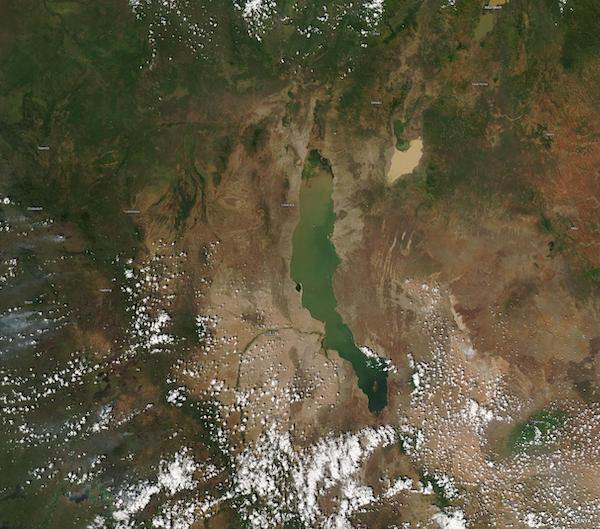Images
December 13, 2020 - Lake Turkana
Tweet
Lake Turkana has been called “the lake that tells the story of humanity’s birth”. Seated in East Africa’s Rift Valley, the saline lake stretches for more than 154 miles (249 km) and measures only 27 miles (44 km) wide, providing scarce water resources in a very dry landscape. More than two million years ago, however, the lake was larger, and the surrounding countryside was more hospitable. Paleontologists have discovered fossils dated as early as 3.4 – 4.2 million years in the Turkana basin on the west side of today’s lake boundaries, which include ancient fish, turtles, rodents, horses, elephant, and primates, evidence of the abundant life found in this region in times past.
In the 1960’s scientists began to work the fossil beds on the east side of the lake. Tools that showed the handiwork of humanity were found in sediment dated at 3.3 million years old. In 1972, a team lead by Richard Leakey discovered a skull and some bones that were subsequently dated back 1.9 million years. This early hominid, Homo rudolfensis, was just one of three hominid species that coexisted in this region between 1.78 and 1.98 million years ago. In 1984 a nearly complete skeleton of a boy who lived between 1.5 and 1.6 million years ago was found near Lake Turkana. Known as Turkana Boy, he is one of the earliest Homo erectus known. The ancient sediments and sandstone of Lake Turkana have truly revealed much about our planet’s ancient history, and the dawning of our species.
On December 10, 2020, the Moderate Resolution Imaging Spectroradiometer (MODIS) on board NASA’s Aqua satellite acquired a true-color image of Lake Turkana. Sediment stains the waters, especially in the muddy-colored northern end. Lake Chew Bahir, the small lake northeast of Lake Turkana also is stained with sediment. Lake Chew Bahir and the northern tip of Lake Turkana sit in Ethiopia. The southern section of Lake Turkana belongs to Kenya.
Image Facts
Satellite:
Aqua
Date Acquired: 12/10/2020
Resolutions:
1km (73.1 KB), 500m (253.5 KB), 250m (782.1 KB)
Bands Used: 1,4,3
Image Credit:
MODIS Land Rapid Response Team, NASA GSFC
Tweet
Lake Turkana has been called “the lake that tells the story of humanity’s birth”. Seated in East Africa’s Rift Valley, the saline lake stretches for more than 154 miles (249 km) and measures only 27 miles (44 km) wide, providing scarce water resources in a very dry landscape. More than two million years ago, however, the lake was larger, and the surrounding countryside was more hospitable. Paleontologists have discovered fossils dated as early as 3.4 – 4.2 million years in the Turkana basin on the west side of today’s lake boundaries, which include ancient fish, turtles, rodents, horses, elephant, and primates, evidence of the abundant life found in this region in times past.
In the 1960’s scientists began to work the fossil beds on the east side of the lake. Tools that showed the handiwork of humanity were found in sediment dated at 3.3 million years old. In 1972, a team lead by Richard Leakey discovered a skull and some bones that were subsequently dated back 1.9 million years. This early hominid, Homo rudolfensis, was just one of three hominid species that coexisted in this region between 1.78 and 1.98 million years ago. In 1984 a nearly complete skeleton of a boy who lived between 1.5 and 1.6 million years ago was found near Lake Turkana. Known as Turkana Boy, he is one of the earliest Homo erectus known. The ancient sediments and sandstone of Lake Turkana have truly revealed much about our planet’s ancient history, and the dawning of our species.
On December 10, 2020, the Moderate Resolution Imaging Spectroradiometer (MODIS) on board NASA’s Aqua satellite acquired a true-color image of Lake Turkana. Sediment stains the waters, especially in the muddy-colored northern end. Lake Chew Bahir, the small lake northeast of Lake Turkana also is stained with sediment. Lake Chew Bahir and the northern tip of Lake Turkana sit in Ethiopia. The southern section of Lake Turkana belongs to Kenya.
Image Facts
Satellite:
Aqua
Date Acquired: 12/10/2020
Resolutions:
1km (73.1 KB), 500m (253.5 KB), 250m (782.1 KB)
Bands Used: 1,4,3
Image Credit:
MODIS Land Rapid Response Team, NASA GSFC




